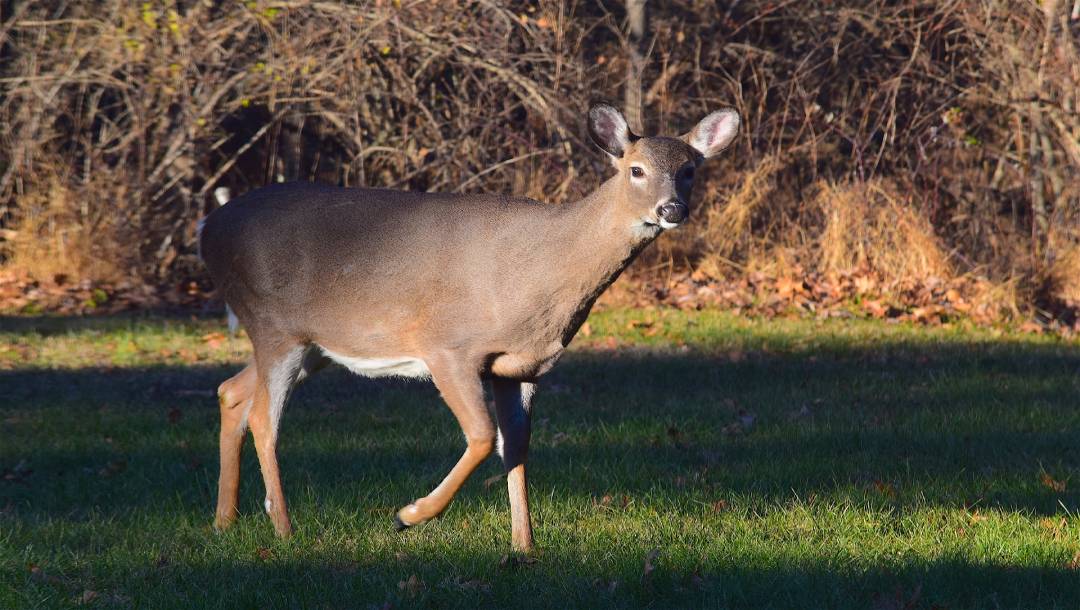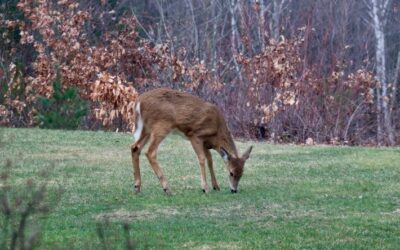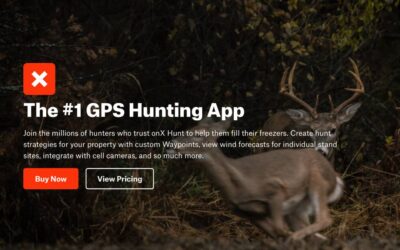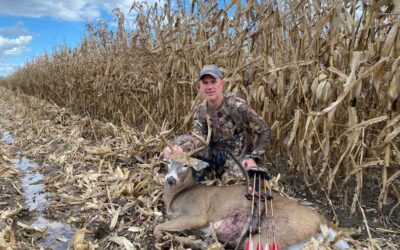1. What is a Whitetail Doe?
A whitetail doe is the smallest deer in the whitetail herd. The most prominent difference of a whitetail doe is that they do not have antlers. Antlers can be found on the head of a whitetail buck. If there are no antlers, then most likely the deer is a doe.
Whitetail doe complete all the areas that the whitetail bucks do not. They provide the other half of the genetic equation for whitetail deer. They are the caring mothers to their fawns. They also are the most important part of the famous whitetail rut, but we will talk about that in a later part.
I cannot talk about whitetail doe without mentioning the button buck.
Have you ever had that dreadful feeling of shooting a “doe” but once you take a closer look you shot a button buck? It may be the second worse thing a whitetail hunter can experience besides wounding an animal.
A button buck is a yearling buck that has not yet grown its antlers. The buck will look smaller like a doe and have all the visual signs that it is a doe except for one tell.
The buck will have small nubs where antlers would normally start to grow. They look like half circles or buttons. Hence the name “button buck.” Make sure to double-check the whitetail doe head to ensure that you are not shooting a button buck. You want to let the bucks grow till you can tell if they are a cull buck.
Now that you know what a whitetail doe is and what it is not, I shall dive into where you can find a whitetail doe.
Table of Contents
What is a Whitetail Doe?
Where can You Find Whitetail Doe?
How do Whitetail Doe Travel?
Why should Hunters Care about Whitetail Doe?
Is it Ethical to Shoot Whitetail Doe?
Conclusion
2. Where can You Find Whitetail Doe?
The number one place where you can find whitetail doe is in the fields feeding. It is important to locate where your food sources are on a specific piece of either private or public land. These rich food sources will be the main place where you can see a doe in daylight.
The second place where the majority of whitetail doe can be found is in bedding areas. For the property that I hunt, the local bedding areas are either in the corn or in a heavy ditch line that is so thick, it’s almost impossible to hunt in. These types of bedding areas can occasionally be sanctuaries for deer. Sanctuaries are locations where there is little hunting pressure and lots of covers. The ditch line I mentions earlier is a sanctuary for the deer on our property.
The location of your hunting stands matters immensely while whitetail deer hunting. You want to place a hunting spot that is on travel corridors and pinch points. These types of locations can be found where the deer are traveling from food to bedding for the morning hunts and from bedding to food for the evening hunts.
It is also a good idea to have some locations looking over certain food sources. These spots are great for rifle hunting due to the long-range of a rifle.
3. How do Whitetail Doe Travel?
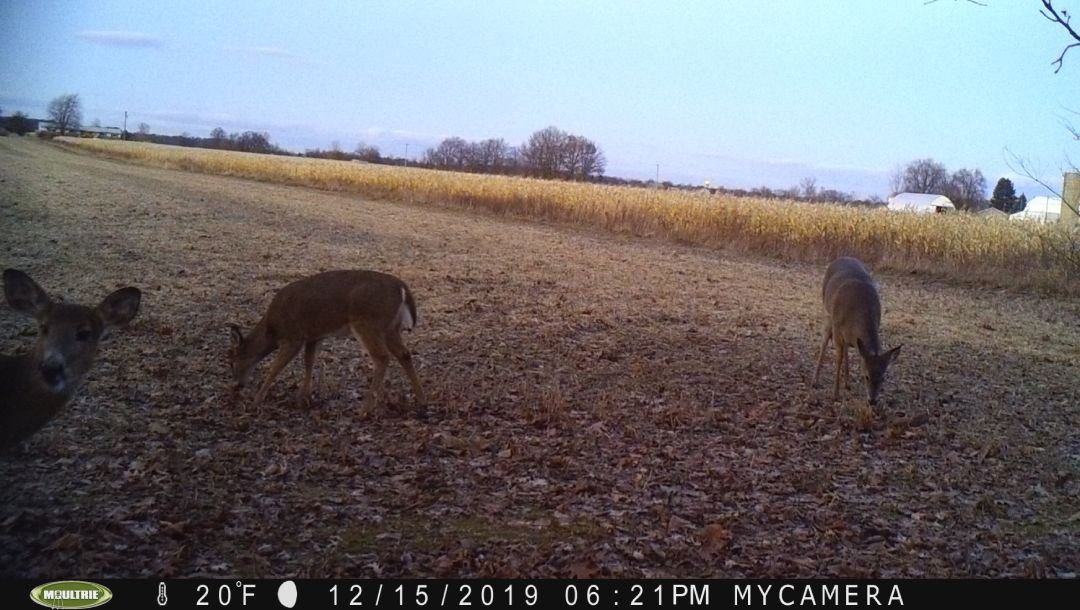
Whitetail Doe tends to travel in groups. This is a picture I captured on a trail camera of 3 does all together feeding.
Whitetail doe tends to travel in groups. The size of the group depends heavily on your buck to doe ratio and how many deer you have on the piece of property you are hunting. For the property that we hunt, it is a normal number to see whitetail doe travel in groups of 3-5. That number includes the fawns.
The fawns that whitetail doe birth in the spring continue to depend on their mothers until they are ready to breed or become bucks that can fend for themselves. It is not uncommon for a whitetail doe to have twins or even triplets. Twins are the most common in my area of hunting. A group of whitetail doe may have two adult doe (1 being infertile) and anywhere from 1-3 fawns.
The idea of having an alpha doe and a beta doe was a new concept to me, but it all made sense after I did some reading about it and paired that with my own experience. There is always that one doe in a group that leads the pack. They are the first to check if the field is safe, they are the first to blow at you and be gone, and they are in the front of the group. These are your alpha doe. They tend to be old, wise, and hard to fool.
The rest of the whitetail doe that follow them are beta doe and just follow the leader so to say.
4. Why should Hunters Care about Whitetail Doe?
The whitetail doe is the single most important part of shooting more bucks. They are the driving factor of the most precious time to be a whitetail deer hunter… the rut. Without the whitetail doe, there is no rut. If there is no rut, then the chances of shooting big bucks during hunting season almost diminish completely. So while you are reading this just take a second and be thankful for whitetail doe and all they do for us as hunters.
The rut in simplified terms is the breeding season for whitetails. Bucks will chase doe in hopes of getting the chance to breed a specific doe when she is ready. The bucks will also fend off any competing bucks which make our grunt calls and rattling antlers so effective as hunters. This is important because as a buck is getting ready to breed a doe, that buck will do anything to keep other bucks from getting to her first.
This is the prime time for us as hunters to exploit the bucks’ basic God-given nature. We need to use our buck grunts, rattling antlers, and decoys to fool a real buck into thinking that another buck is in the area. If a buck, especially a dominant buck on your property, thinks that there is a threat to its breeding rights, they will come and challenge or fight. Little do they know that there was no real buck. However, now you have a buck hopefully within shooting range. That is why you should understand the whitetail doe because, without them, none of that is possible.
Another notable concept that hunters need to understand is that whitetail doe is the other half of the breeding equation. If you are having trouble growing bigger bucks on your property, it may not be the bucks’ genetics at all. It may be a doe in the herd that has bad genetics.
Culling bucks seems to be a strategy that serious hunters use to “help the herd.” However, the fact of the matter is that it may not even be the bucks’ fault in the first place. It may be the whitetail doe. I am not trying to judge anyone for culling bucks. I think that culling bucks are a decent way to help the herd the best you can. I just want any hunter to understand that it may not even be the buck that is causing the problem.
5. Is it Ethical to Shoot Whitetail Doe?

This was my first doe with my bow. What a great day it was!
Shooting a whitetail doe is completely ethical and in my hunting plan, it is advised. I hunt in a location where the doe amount is too high. I try my best to shoot at least one doe early in the season. I do this because I want to play my role of helping the whitetail population in my area stay healthy, have enough resources, and not get overcrowded. If I only shot mature bucks, then I would spend a lot of time without meat in the freezer. I do not always shoot mature bucks every year. A mature whitetail buck is challenging to chase and as a hunter, sometimes it just doesn’t happen every year.
The more whitetail doe you have on your property also impacts your likely hood of seeing mature bucks during the rut. If you have too many whitetail doe, bucks will find it easy to get locked down with a doe and stop cruising the woods. The fewer time bucks in your area are cruising the woods looking for whitetail doe in estrus, the lower the chances of you getting to see mature bucks during daylight.
My recommendation for shooting whitetail doe is to try to shoot at least one doe for every one buck you shoot on your property. These are guidelines and what I have found to be helpful on my property. Make sure to test out your strategies or hire a whitetail consultant to help you form a plan.
Conclusion
The whitetail doe is an important variable to the never-ending chase of mature whitetail bucks. There is no secret that shooting a whitetail doe is less exciting than shooting a monster buck. However, it is crucial to Learn about the whitetail doe, Plan how the whitetail doe will be incorporated into your property management goals, and then go Execute on that plan in the woods.
Thank you guys for visiting The Whitetail Teacher! If you enjoyed this post make sure to share it with a friend.
Join the Hunters of America Discord Server to become a part of the only hunting discord community.
You can also show support by going over to the socials listed below and giving me a follow. I appreciate it and it helps keep spreading the love for Whitetail Deer Hunting.
If you have any questions or recommendations for new blog posts, please email me and I will respond as quickly as I can: Loganpetzold@thewhitetailteacher.com
Learn, Plan, Execute,
The Whitetail Teacher

